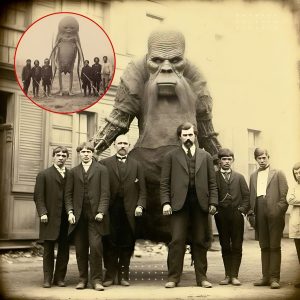In a groundbreaking archaeological excavation, a team of researchers has unearthed an ancient skull that promises to revolutionize our understanding of human history. This remarkable discovery, which has captivated the scientific community and garnered global attention, provides unprecedented insights into anthropology and archaeology.
The excavation site, nestled in a remote region known for its rich archaeological heritage, yielded the well-preserved skull of an individual who lived thousands of years ago. The skull, meticulously extracted from layers of sediment and carefully preserved, offers a rare glimpse into the physical characteristics and lifestyle of ancient humans.

Anthropologists and archaeologists immediately recognized the significance of the find. Detailed analysis of the skull’s structure, dental remains, and cranial features has already begun to yield valuable information about the individual’s age, health, and possible cultural practices. Such insights are crucial for piecing together the puzzle of human evolution and migration patterns.
Initial examinations suggest that the individual belonged to a specific ancient population known for unique anatomical traits and cultural practices. The skull’s distinctive features provide clues about diet, health, and possibly social structures within the ancient community.

Moreover, the discovery opens new avenues for exploring broader questions in anthropology and archaeology. Researchers are eager to compare the findings with existing data from other archaeological sites, hoping to trace connections and interactions between different ancient civilizations.
The excavation team, comprised of seasoned archaeologists and forensic experts, has employed cutting-edge technology and meticulous methodology to ensure the skull’s preservation and accurate analysis. Every detail—from the skull’s dimensions to the wear patterns on its teeth—promises to contribute to a deeper understanding of our shared human heritage.
As news of the discovery spreads, experts and enthusiasts alike are buzzing with anticipation over the potential revelations that lie ahead. The study of ancient skulls not only sheds light on individual lives but also informs broader narratives of human history, resilience, and adaptation across diverse environments and timescales.

Beyond its scientific implications, the discovery underscores the enduring allure of archaeology as a window into our past. It reminds us of the importance of preserving and interpreting archaeological sites with care and respect, ensuring that future generations can continue to unravel the mysteries of human civilization.
The excavation of the ancient skull stands as a testament to the dedication and expertise of the archaeological community in uncovering humanity’s shared story. It reaffirms the value of interdisciplinary research and collaborative efforts in piecing together the intricate tapestry of human evolution and cultural diversity.

As researchers continue their painstaking analysis of the ancient skull and its surrounding context, anticipation mounts for the revelations that will shape our understanding of human history for years to come. The breaking news of this discovery serves as a poignant reminder of our quest for knowledge and our connection to the past, woven through the delicate threads of time and discovery.
In a groundbreaking archaeological excavation, a team of researchers has unearthed an ancient skull that promises to revolutionize our understanding of human history. This remarkable discovery, which has captivated the scientific community and garnered global attention, provides unprecedented insights into anthropology and archaeology.
The excavation site, nestled in a remote region known for its rich archaeological heritage, yielded the well-preserved skull of an individual who lived thousands of years ago. The skull, meticulously extracted from layers of sediment and carefully preserved, offers a rare glimpse into the physical characteristics and lifestyle of ancient humans.

Anthropologists and archaeologists immediately recognized the significance of the find. Detailed analysis of the skull’s structure, dental remains, and cranial features has already begun to yield valuable information about the individual’s age, health, and possible cultural practices. Such insights are crucial for piecing together the puzzle of human evolution and migration patterns.
Initial examinations suggest that the individual belonged to a specific ancient population known for unique anatomical traits and cultural practices. The skull’s distinctive features provide clues about diet, health, and possibly social structures within the ancient community.

Moreover, the discovery opens new avenues for exploring broader questions in anthropology and archaeology. Researchers are eager to compare the findings with existing data from other archaeological sites, hoping to trace connections and interactions between different ancient civilizations.
The excavation team, comprised of seasoned archaeologists and forensic experts, has employed cutting-edge technology and meticulous methodology to ensure the skull’s preservation and accurate analysis. Every detail—from the skull’s dimensions to the wear patterns on its teeth—promises to contribute to a deeper understanding of our shared human heritage.
As news of the discovery spreads, experts and enthusiasts alike are buzzing with anticipation over the potential revelations that lie ahead. The study of ancient skulls not only sheds light on individual lives but also informs broader narratives of human history, resilience, and adaptation across diverse environments and timescales.

Beyond its scientific implications, the discovery underscores the enduring allure of archaeology as a window into our past. It reminds us of the importance of preserving and interpreting archaeological sites with care and respect, ensuring that future generations can continue to unravel the mysteries of human civilization.
The excavation of the ancient skull stands as a testament to the dedication and expertise of the archaeological community in uncovering humanity’s shared story. It reaffirms the value of interdisciplinary research and collaborative efforts in piecing together the intricate tapestry of human evolution and cultural diversity.

As researchers continue their painstaking analysis of the ancient skull and its surrounding context, anticipation mounts for the revelations that will shape our understanding of human history for years to come. The breaking news of this discovery serves as a poignant reminder of our quest for knowledge and our connection to the past, woven through the delicate threads of time and discovery.





